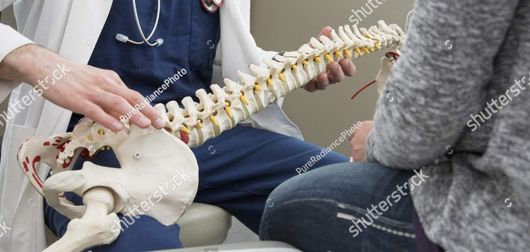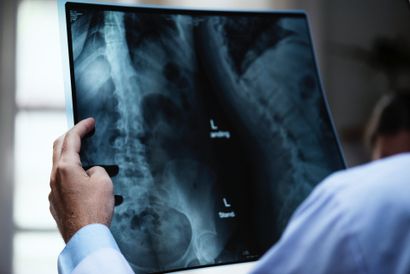Due to Covid - 19 we are accepting appointments over the phone only.
If you would like an appointment please call us at (502) 239-3993.

ABOUT CHIROPRACTIC
Automobile Injury
You may have heard the comment, “If there’s no damage to the car, then there’s no injury.” Unfortunately, that does not always seem to be the case.
There are MANY factors that affect the dynamics of a collision and whether or not injury occurs. A short list includes: vehicle type and design, speed, angle of collision . . .
Neck Pain
Because the human head weighs between 12-15 pounds (5.44-6.80 kg), the neck and upper back muscles must constantly work to maintain an upright posture. Due to our use of computer and electronic devices, many people have forward head posture (FHP), meaning their head rests forwards on the neck more than it should. In fact, studies . . .
Joint Health
One of the most painful things a person can experience is joint pain. Shoulder, knees and hips as well as other areas can be kept in a health mode with certain exercises sometimes Chiropractic help.

Chiropractic is an overall way of looking at the human body and taking a natural systemic approach to healing. It's based on the idea that the body is self-sustaining and self-healing. The body is in essence completely controlled by the brain through its connection via the spinal cord and the vast networks of nerves that make up the body. It is the super computer and connections that when it not functioning at its peak, the overall performance of the human body is lacking.
In the chiropractic world, drugs and medicine are not utilized as a form of treating a patient. While supplementation and nutrition are almost always a part of the bigger picture, drugs and prescriptions can be viewed as band-aids to treat symptoms rather than going to the source and treating the real problem.
While it's often perceived that the chiropractor is solely here to treat back and neck pain, this is simply a small piece of what the profession really is capable of handling. Chiropractors not only treat soft and hard tissue problems such as sciatica and joint pain, but are largely called on to deal with more significant issues. Some of these issues include fibromyalgia, allergies, insomnia, headaches and many more.
Personal Injury
Personal injury is related to bodily harm that comes from being involved in any type of accident or mishap. The difference between personal injury and workers comp is that personal injury takes place outside of work. Chiropractors are professionals at uncovering underlying issues in personal injury accidents. Whether it be a single adjustment or a series of treatment, your chiropractor is one of the best options to get you healing on the right path and back to near perfect.
Headaches
Migraines affect approximately 15% of the general population and are usually managed by medication. However, this traditional treatment approach is not well tolerated by some migraine sufferers due to side effects. Additionally, some people prefer to avoid the risks associated with taking some medications over the long term. A systematic literature review of randomized controlled . . .
Whole Body Health
Primarily, chiropractic focuses on the diagnosis and treatment of neuromuscular disorders with an emphasis on treatment utilizing manual adjustments and other types of manipulation and/or mobilization of the spine. Chiropractic is classified as a form of primary care, as anyone can choose to see a doctor of chiropractic without a referral. A 2010 meta analysis . . .
Chiropractic is an overall way of looking at the human body and taking a natural systemic approach to healing. It's based on the idea that the body is self-sustaining and self-healing. The body is in essence completely controlled by the brain through its connection via the spinal cord and the vast networks of nerves that make up the body. It is the super computer and connections that when it not functioning at its peak, the overall performance of the human body is lacking.
In the chiropractic world, drugs and medicine are not utilized as a form of treating a patient. While supplementation and nutrition are almost always a part of the bigger picture, drugs and prescriptions can be viewed as band-aids to treat symptoms rather than going to the source and treating the real problem.
While it's often perceived that the chiropractor is solely here to treat back and neck pain, this is simply a small piece of what the profession really is capable of handling. Chiropractors not only treat soft and hard tissue problems such as sciatica and joint pain, but are largely called on to deal with more significant issues. Some of these issues include fibromyalgia, allergies, insomnia, headaches and many more.
History of Chiropractic (Top)
Did you know that chiropractic dates back to the time of Hippocrates? He believed that if the spine was misaligned, it greatly contributed to the health of an individual.
The modern day school of chiropractic dates back to 1895, when Dr. Daniel Palmer adjusted a man that had lost his hearing 17 years prior. The story goes that prior to losing his hearing the man had heard something pop in his back. Upon the adjustment of the man's misaligned vertebrae his hearing greatly improved.
While the medical community criticized this new technique for healing the body, the people who followed in these footsteps found an amazing new way of dealing with illness and disease. Dr. Palmer's theories are still discussed in the chiropractic industry today. Without this man's input into medicine in a time where he was greatly discredited, the millions of people today who enjoy the life changing benefits may never have had this opportunity. There is still a school named after Dr. Daniel Palmer as well as over 20 schools and thousands of chiropractic students across the country.
History of Chiropractic (Top)
Did you know that chiropractic dates back to the time of Hippocrates? He believed that if the spine was misaligned, it greatly contributed to the health of an individual.
The modern day school of chiropractic dates back to 1895, when Dr. Daniel Palmer adjusted a man that had lost his hearing 17 years prior. The story goes that prior to losing his hearing the man had heard something pop in his back. Upon the adjustment of the man's misaligned vertebrae his hearing greatly improved.
While the medical community criticized this new technique for healing the body, the people who followed in these footsteps found an amazing new way of dealing with illness and disease. Dr. Palmer's theories are still discussed in the chiropractic industry today. Without this man's input into medicine in a time where he was greatly discredited, the millions of people today who enjoy the life changing benefits may never have had this opportunity. There is still a school named after Dr. Daniel Palmer as well as over 20 schools and thousands of chiropractic students across the country.
Four Phases of Spinal Degeneration (Top)
Phase 1
The first stage of spinal degeneration is when there is a minor loss of normal spine balance and spinal curvature. The surrounding features of the spine such as nerves, discs and joints begin to age quicker and are continually more stressed. This stage of the degeneration process rarely is accompanied with any major pain. At this point, there is a good chance that with the proper care, you can return to normal.
Phase 2
In the second stage of spinal degeneration, there is a often narrowing of the discs and potentially deformation in the bones. Your posture is often beginning to degenerate as well at this point. As the spinal canal, or opening begins to narrow, there are often significant aches and pains associated. Fatigue and stress are more common at this stage. There is a good chance of improvement at this stage with the proper care.
Phase 3
In the third stage of spinal degeneration, there is significant physical and mental involvement due to the level of issues here. There is most likely nerve damage as well as deformation of the bones and discs. There would be a significant loss of energy and height at this point. Some reversal is possible.
Phase 4
In the fourth stage of spinal degeneration, most damage is permanent including scar tissue, nerve damage and deformation. At this point, the condition is irreversible. Management of pain and discomfort is the best option here.
Four Phases of Spinal Degeneration (Top)
Phase 1
The first stage of spinal degeneration is when there is a minor loss of normal spine balance and spinal curvature. The surrounding features of the spine such as nerves, discs and joints begin to age quicker and are continually more stressed. This stage of the degeneration process rarely is accompanied with any major pain. At this point, there is a good chance that with the proper care, you can return to normal.
Phase 2
In the second stage of spinal degeneration, there is a often narrowing of the discs and potentially deformation in the bones. Your posture is often beginning to degenerate as well at this point. As the spinal canal, or opening begins to narrow, there are often significant aches and pains associated. Fatigue and stress are more common at this stage. There is a good chance of improvement at this stage with the proper care.
Phase 3
In the third stage of spinal degeneration, there is significant physical and mental involvement due to the level of issues here. There is most likely nerve damage as well as deformation of the bones and discs. There would be a significant loss of energy and height at this point. Some reversal is possible.
Phase 4
In the fourth stage of spinal degeneration, most damage is permanent including scar tissue, nerve damage and deformation. At this point, the condition is irreversible. Management of pain and discomfort is the best option here.

What is a Subluxation? (Top)
When a vertebrae becomes misaligned or the joints between vertebrae do not move fully, this is referred to in the chiropractic profession as a subluxation. Subluxations can be caused by a wide range of issues ranging from a minor slip or bump to a car accident or any sudden trauma. When a vertebrae is subluxated, it begins to put pressure on nerves, blood vessels and everything around it. This pressure comes with a price. The subluxation interrupts the natural pathways that the messages sent from the brain need to be clear in order to be completed properly.
As time goes by and a subluxation remains untreated, the spine and surrounding features such as discs can begin to degenerate. This degeneration becomes more difficult to reverse as time goes by as the surrounding muscles, nerves and bones begin to adjust to the new shape. The body is an amazing machine. It will start to accommodate these changes by compensating in other areas. The longer this goes on, the more difficult it is and the longer it takes to get back to near perfect position.
What is a Subluxation? (Top)
When a vertebrae becomes misaligned or the joints between vertebrae do not move fully, this is referred to in the chiropractic profession as a subluxation. Subluxations can be caused by a wide range of issues ranging from a minor slip or bump to a car accident or any sudden trauma. When a vertebrae is subluxated, it begins to put pressure on nerves, blood vessels and everything around it. This pressure comes with a price. The subluxation interrupts the natural pathways that the messages sent from the brain need to be clear in order to be completed properly.
As time goes by and a subluxation remains untreated, the spine and surrounding features such as discs can begin to degenerate. This degeneration becomes more difficult to reverse as time goes by as the surrounding muscles, nerves and bones begin to adjust to the new shape. The body is an amazing machine. It will start to accommodate these changes by compensating in other areas. The longer this goes on, the more difficult it is and the longer it takes to get back to near perfect position.





